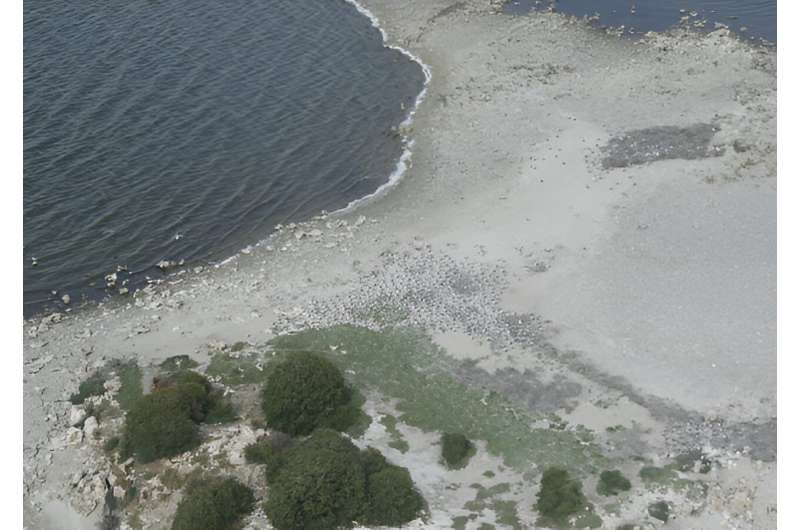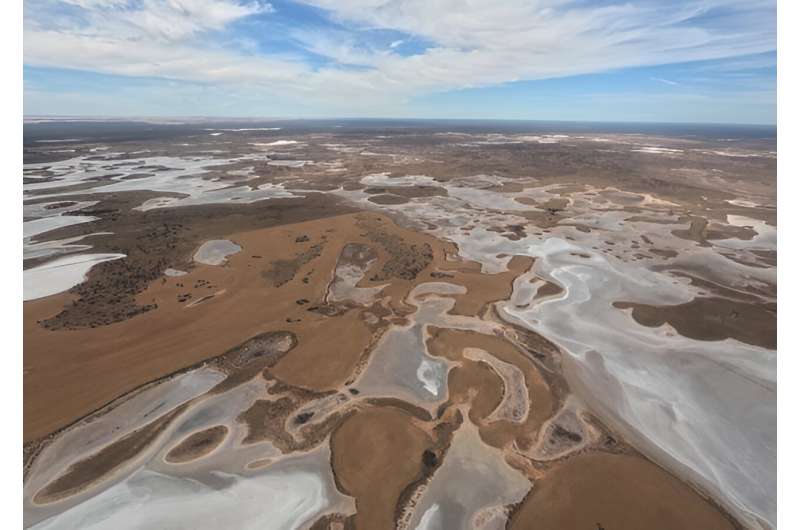This article has been reviewed according to Science X's editorial process and policies. Editors have highlighted the following attributes while ensuring the content's credibility:
fact-checked
trusted source
proofread
Waterbird numbers up after La Niña years: Aerial survey

Widespread flooding and environmental flows have been a boon for our waterbirds and wetlands—but long-term decline is persisting.
Significant rainfall over the past few La Niña years has boosted waterbird numbers in eastern Australia, the results from this year's aerial waterbird survey show.
The annual survey by UNSW researchers and government collaborators revealed there was widespread breeding of waterbirds in 2021 and 2022 throughout eastern Australia, particularly in the Murray-Darling Basin. The numbers of waterbirds have increased to more than half a million individuals—during this year's survey, the researchers counted 579,641 birds.
The survey, led by UNSW's Center for Ecosystem Science with major partner NSW Department of Planning and Environment and other state government collaborators, covers a third of the continent and provides one of Australia's most important long-term datasets on the health and biodiversity of the country's river and wetland areas. The survey also comprehensively covers the major rivers and wetlands of the Murray-Darling Basin.
"It's great to see such a jump in numbers from previous years, ranked seventh highest in the last 41 years, showing the importance of the widespread flooding and environmental flows that we have seen in the last three years," says Center for Ecosystem Director Professor Richard Kingsford, who leads the aerial survey.
However, the scientists also found the four major markers for waterbird health—total abundance, breeding index, number of species breeding and wetland area index—have continued to show significant declines over time.
"The results are still showing a long-term decline and so the long-term loss of waterbirds has not been reversed. If we leave aside 1983 and 1984, the peak years, three of the four major indices still show a significant downward trend—and long-term trends are more informative for predicting population status than year-to-year fluctuations," Prof. Kingsford says.
The scientists found waterbirds were most abundant in the temporary wetlands of the Georgina-Diamantina River system in northwestern Queensland, with Lakes Mumbleberry and Torquinnie supporting more than 180,000 waterbirds. There were also more than 50,000 waterbirds south of the Coorong, in the southeast wetlands.
After widespread rainfall in 2022, 72% of waterbirds were located across 30 wetlands, making them less spatially concentrated and more evenly distributed than the previous year.
The coming big dry
Despite this big lift in numbers, the scientists recorded little breeding in 2023, reflecting the impacts of El Niño and the drying of eastern Australia. Wetland area index—the total area of wetlands, coming in at 192,083 ha this year—also decreased considerably from the previous flood year of 2022, and lies well below the long-term average.
Drier conditions have returned to much of Australia after the La Niña years, with October rainfall 65% below the 1961–1990 average across Australia. Many of the large wetlands surveyed in 2023 are drying right back.

"Breeding species' richness and abundance decreased considerably compared to the previous year, with breeding abundance falling by an order of magnitude to slightly below the long-term average," says the survey's co-ordinator, Dr. John Porter, Senior Scientist from the NSW Department of Planning and Environment.
Some rivers and wetlands in the northern Lake Eyre Basin, including the Diamantina and Georgina rivers, retained water in deeper channels and pools after moderate flooding, and supported large numbers of waterbirds.
Wetland survey
The team also comprehensively surveyed all the major wetlands across the Murray-Darling Basin, a separate survey funded by the Murray-Darling Basin Authority and now in its 17th year for the wetlands of the River Murray, including the Coorong and Lower Lakes.
"Waterbird numbers were much higher in the Lower Lakes and Coorong than we have seen in recent years, with breeding of straw-necked ibis, Australian pelicans and pied cormorants in their usual breeding sites of up to several thousand," said Prof. Kingsford.
"These long-term data are critical to identifying trends in the health of rivers and wetlands and it is important that we continue to track these changes so that we can identify the problems and solutions, with degradation trends emerging above the high variability of our river systems.
"The implementation of the Murray-Darling Basin Plan is critical, most importantly ensuring that the floods continue to bring health to our rivers and their waterbirds, with the new major amendments further contributing to the recovery of rivers, wetlands and their biodiversity."
Provided by University of New South Wales




















